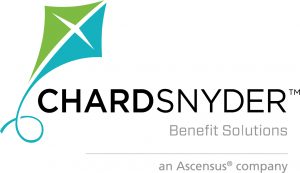 From time to time, Wrangle will invite a fellow Ascensus company to bring its expertise on various employee benefit attributes to the table. The purpose of these blogs is to provide an additional source of information to you, while maintaining the true journalistic standards set by Wrangle.
From time to time, Wrangle will invite a fellow Ascensus company to bring its expertise on various employee benefit attributes to the table. The purpose of these blogs is to provide an additional source of information to you, while maintaining the true journalistic standards set by Wrangle.
***
Being Better Prepared for 2020
According to a Kaiser Family Foundation survey, paying for healthcare is now the number one concern for Americans. The 2018 Milliman Medical Index found the total annual cost of healthcare for an American family of four now tops $28,000.
Wrangle asked Chard Snyder Two Key Questions to Help You Be Better Prepared Going into 2020.
1. We all are aware of the rising consumer healthcare costs and increased employer spending. What needs to take shape for 2020 to have a better handle on the costs?
Answer: 2020 needs to provide focused education initiatives and decision support tools.
How can brokers help?
What brokers need to do for the employee-side, is to help them make wise healthcare benefits decisions through education, and as for employers, the broker needs to provide a means to evaluate options and make the best plan choices for the unique needs of their businesses and their employees. This can be accomplished by technology.
- Employers need cutting-edge technology platforms that provide easy access to reporting, analytics, file sharing, and plan adoption/engagement tools.
- Employees need smart features like interactive portals and mobile apps that provide secure on-the-go access to their benefits accounts 24/7.
- Employers also need Artificial intelligence (AI)-driven solutions and support systems that are evolving with this fast pace world.
Suggestion on What to Discuss with Employers and Employees:
The convergence of health benefits and retirement savings.
Pre-tax HSA funds can be used now to pay for eligible healthcare expenses, but also invested tax-free and then withdrawn tax-free in retirement. At age 65 or older, HSA monies can also be used for non-medical purposes without incurring the usual 20% penalty (although it will be taxed as income if used for non-medical purposes). Employers are beginning to see the benefit of contributing to an HSA, as well as a 401(k), to help employees with both present and future healthcare expenses.
Per the 2019 WEX Health Study, only 17% of employees are aware an HSA can be used as a retirement tool.
Did You Know?
- Per Fidelity, the average couple needs over $285,000 to fund healthcare costs in retirement 1.
- According to Presagia, 33% of employers still manually manage and track FMLA leave.
2. What do brokers need to keep in mind for FMLA administration?
Employers are increasingly at risk. HR managers and supervisors can be held personally liable for FMLA violations. Employers can be sued for alleged leave interference, retaliation for taking leave, and discrimination against employees on leave. Potential damages for employers include:
- Lost wages for back pay and front pay
- Liquidated damages
- Attorney costs and fees
- Court orders
- EEOC & DOL fines
Could your client be at risk? See the stats below.
- From 2012-2016, there was a 200% increase in FMLA lawsuits.
- 7%: Average percentage of the US workforce that is on FMLA leave at any point in time.
- 14 workdays are the average absence.
- To be eligible for FMLA leave, employees must work at a location where the employer has a minimum of 50 employees within a 75-mile radius.
- Employers with locations in multiple states face greater difficulties with leave tracking.
- Employers are obligated to notify employees that FMLA leave is available.
How can brokers help?
Line up outsourcing-leave administration to remain compliant and avoid the risk of litigation and financial liability. Alternatively, brokers may want to inquire if the disability carrier can assist, although many carriers have employer size requirements.
***
About Chard Snyder
For over 31 years, Chard Snyder, a wholly owned subsidiary of Ascensus, has served as a third-party administrator of employee benefit solutions, providing expert administration for healthcare savings and spending accounts (HSA, FSA, HRA, Commuter), benefit continuation services (COBRA; retiree, direct & other billing), and FMLA leave.
Chard Snyder provides “no noise” personal service through a dedicated team focused on responsiveness, flexibility, smart technology, and compliance.
Chard Snyder serves all industries, with higher education, healthcare, manufacturing, municipalities, banking and financial as key markets.
They currently serve nearly 1,500 clients (with an employee base ranging from a few to over 400,000) throughout the US.
Contact at Chard Snyder to ask questions on blog post or inquire for more information: Noelle Oedy, noelle.oedy@chard-snyder.com
1 Fidelity Benefits Consulting estimate; 2019. Estimate based on a hypothetical couple retiring in 2019, 65 years old, with life expectancies that align with Society of Actuaries’ RP-2014 Healthy Annuitant rates with Mortality Improvements Scale MP-2016. Actual expenses may be more or less depending on actual health status, area of residence, and longevity. Estimate is net of taxes. The Fidelity Retiree Health Care Costs Estimate assumes individuals do not have employer-provided retiree health care coverage, but do qualify for the federal government’s insurance program, Original Medicare. The calculation takes into account cost-sharing provisions (such as deductibles and coinsurance) associated with Medicare Part A and Part B (inpatient and outpatient medical insurance). It also considers Medicare Part D (prescription drug coverage) premiums and out-of-pocket costs, as well as certain services excluded by Original Medicare. The estimate does not include other health-related expenses, such as over-the-counter medications, most dental services and long-term care.
